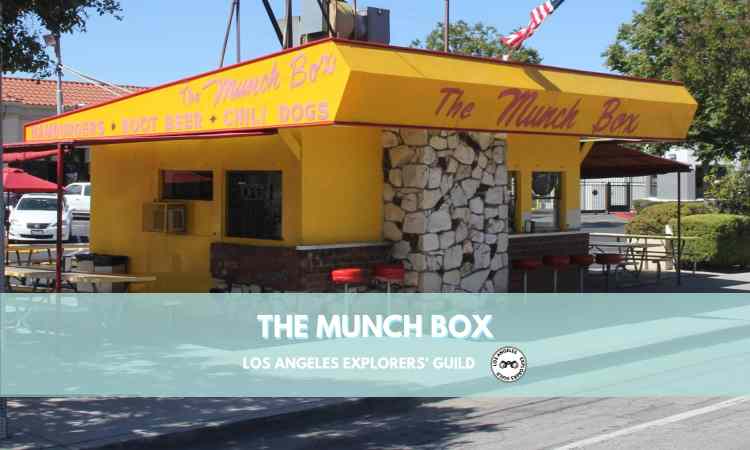Abbey San Encino
It’s not an abbey and it’s nowhere near Encino, but Highland Park’s Abbey San Encino has a storied history in both the local artists movement and in the Los Angeles music scene.
How to Build an Abbey
In 1915 Clyde Browne — of Browne & Cartwright, the company that printed USC’s Daily Trojan and Occidental College’s weekly paper — started building his home along the Arroyo Seco, just off what was then Pasadena Avenue (now Figueroa Street).

He used rocks taken from the Arroyo Seco as well as whatever other materials he could get his hands on (not unlike Albert Emmanuel Sederquist did a decade later with his Hermon Car Wall). Browne even built his own railroad (which he named the CB and J Railway — the J for his younger son Jack) from the property down to the banks of the Arroyo Seco to facilitate rock harvesting.
The Latest Exploration …
Alta Cienega Motel: The Other Morrison Hotel
It’s been called the most disgusting hotel in Los Angeles. It’s also been called a must-see destination for any serious fan of The Doors. No, it’s not Morrison Hotel. It’s Jim Morrison’s final home in West Hollywood.
Keep readingIn addition to rocks from the adjacent riverbed, Browne used bits and pieces from the ruins of European buildings (including Westminster Abbey and the Tower of London), scrounged rocks and bricks from demolished local buildings, metal from dilapidated cars, and bells from train and fire engines and Garvanza Elementary School to craft his dream house. It’s said he even used material from the San Gabriel Mission.
Community Building and Collaboration
Clyde was a true printer at heart — he laid out the plans for the ambitious construction of the Abbey San Encino in picas (a measurement used in type) — and opened a print shop in the Abbey as he was building it. He really wanted to start a Roycroft-like community in Garvanza, building off the artistic movement already on the rise in the small community.
Browne worked with the local stained glass masters at Judson Studios to build and install a circular stained glass window in the front of the building facing Arroyo Glen Street. The window, which details a Franciscan monk reading a manuscript while a Native American man works the printing press, was intended by Browne to represent California’s first printing press.
The window bears the Anglo-Saxon phrase “In tyme of fadres olde,” taken from Chaucer’s Canterbury Tales. On occasion, Browne would use this image as his printer’s mark.
Another local artisan, Pasadena’s Ernest Batchelder (yes, he of the Dutch Chocolate Shop), contributed his tile-making talents by crafting the Abbey’s fireplace.
Browne was a huge fan of the Medieval look, and his home is based on places like Holyrood Castle and Notre Dame Cathedral in Paris (specifically the gargoyles that decorate the Abbey San Encino’s interior).
He was also influenced, as is evident by looking at it, some of the California Missions. The interior of the Abbey features a number of dungeons, a cellar, a refectory, and a chapel. Over the years, the chapel was host to many weddings. Browne (who worked as a piano player before he started his printing company) often played the chapel’s organ — an instrument that had been shipped from Germany and hand-assembled and installed by Browne — at these celebrations.

The Abbey is a unique artifact of early 20th century Los Angeles. There’s nothing else quite like it, and it’s been recognized as a Los Angeles Historic-Cultural Monument (No. 106, granted on November 15, 1972).
Browne finished working on the building in 1921, but he didn’t move his family there until 1924. Today, the Abbey San Encino remains a private home — still owned by the Browne family as near as we can tell — and it’s often locked behind a chain link fence. But if you’re a fan of the interesting architecture found in Los Angeles, it’s worth taking a walk by.
The Rock & Roll Legacy of Abbey San Encino
The Abbey San Encino has a direct connection to the rock & roll scene of 1970s Los Angeles. Clyde Browne, who died in 1942, was the grandfather of singer-songwriter Jackson Browne (who’s first name is Clyde), the man behind such hits as “Doctor, My Eyes,” Lawyers in Love,” “The Pretender,” and “Running on Empty.”
The younger Browne grew up in Los Angeles and spent time as a youth living at the Abbey. In fact, the cover of Browne’s second album, For Everyman, features the singer sitting in the courtyard of the Abbey.

Just across the street …
The First Utility Pole in Los Angeles
Everything has to start somewhere. And this site, location of the first utility pole in Los Angeles, marks the beginnings of the Los Angeles Department of Water & Power.
Keep readingAbbey San Encino
- 6211 Arroyo Glen St (at Figueroa St), Highland Park
- GPS Coordinates: 34.113352, -118.185491 [ Google Maps ]
- what3words: ///calls.monks.faded
Thank you for visiting the Los Angeles Explorers Guild. If you’re enjoying our explorations of Los Angeles, please consider supporting us on Patreon or making a one-time donation via PayPal. We appreciate your support.
Our Most Recent Explorations










Jackson Browne must own this property then he should fix the pagoda house…
LikeLike